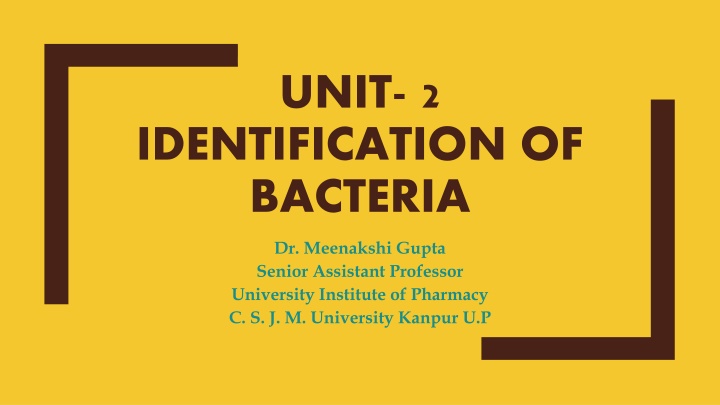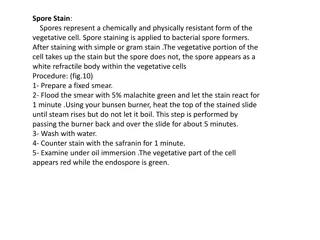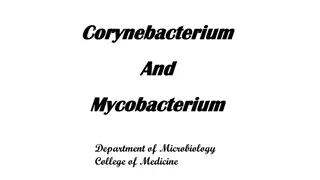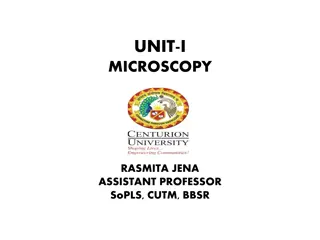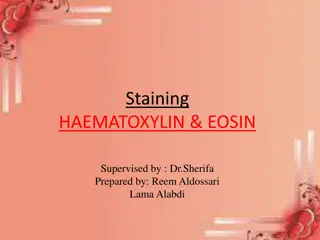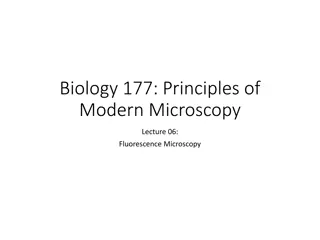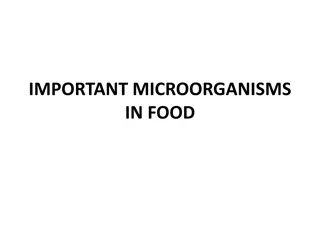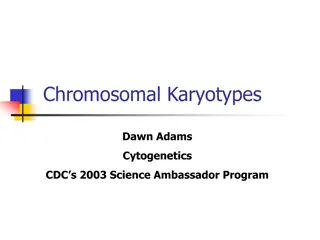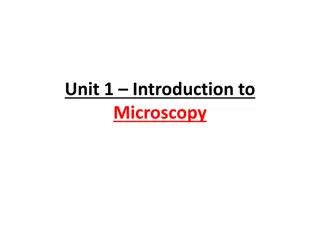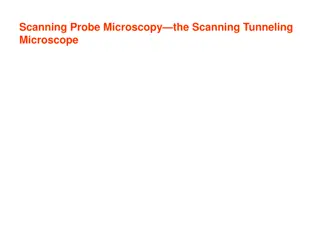Bacteria Identification Techniques: Staining and Microscopy Overview
Staining techniques in microbiology play a crucial role in visualizing bacteria under microscopes. This content covers the importance of staining, types of dyes, wet and dry mounts, hanging drop technique, and different types of staining methods employed in identifying bacteria. Explore the basics of staining and microscopy for effective bacterial analysis.
Download Presentation

Please find below an Image/Link to download the presentation.
The content on the website is provided AS IS for your information and personal use only. It may not be sold, licensed, or shared on other websites without obtaining consent from the author.If you encounter any issues during the download, it is possible that the publisher has removed the file from their server.
You are allowed to download the files provided on this website for personal or commercial use, subject to the condition that they are used lawfully. All files are the property of their respective owners.
The content on the website is provided AS IS for your information and personal use only. It may not be sold, licensed, or shared on other websites without obtaining consent from the author.
E N D
Presentation Transcript
UNIT- 2 IDENTIFICATION OF BACTERIA Dr. Meenakshi Gupta Senior Assistant Professor University Institute of Pharmacy C. S. J. M. University Kanpur U.P
Contents Introduction Dye or Stain Wet mount and Dry mount Identification of bacteria using staining techniques (simple, Gram s &Acid fast staining) and biochemical tests (IMViC).
Introduction Staining is technique used in microscopy to enhance contrast in the microscopic image. Because microbial cytoplasm is usually transparent, it is necessary to stain microorganisms before they can be viewed with the light microscope.
Why we need to stain bacteria? Bacteria are transparent and colorless, so they would be invisible to naked eye if observed under a microscope thus bacteria should be stained with certain dyes in order to visualize bacterial cell or their internal structures using the light microscope
Dye or Stain Dyes are colored organic compound in the form of salt, composed of positive and negative ion, one of these ions is responsible for color called chromogen. they adheres to a cell and give the color to cell. The presence of color gives the cells significant contrast so they are much more visible. Different stains have different organisms, or different parts of organisms. affinities for different Types of dyes: 1. Basic dyes-are water soluble cationic dye. Examples: crystal violet, methylene blue and safranin 1. Acidic dyes -are water soluble anionic dye. Examples: nigrosin and India ink
Wet mount & Dry mount When microorganisms are very large or when motility is to be studied, and a drop of the microorganisms can be placed directly on the slide and observed. A preparation such as this is called a wet mount.
Hanging drop Technique wet mount can also be prepared by placing a drop of culture on a cover slip (a glass cover for a slide) and then inverting it over a hollowed out slide. This procedure is called the hanging drop. https://microbeonline.com/procedure-hanging-drop-method-test-bacterial-motility/
Type of Staining Direct staining - The organism is stained and background is left unstained Negative staining - The background is stained and the organism is left unaltered Stains are classified as Simple stain Differential stain Structural or special stains
Staining Simple Staining Differential Staining Gram Differential Staining Positive Staining Negative Staining Acid Fast Staining
Simple staining techniques is used to study the morphology of bacterial cell Only a single stain is used Positive Staining: Staining is performed with basic dyes such as crystal violet or methylene blue, positively charged dyes that are attracted to the negatively charged materials of the microbial cytoplasm. This technique is called the positive stain technique. InSimple positive staining: all bacteria are colored. Negative Staining: Staining is performed with acidic dyes such as such as nigrosin or Congo red, acidic, negatively charged dyes. They are repelled by the negatively charged cytoplasm and gather around the cells, leaving the cells clear and unstained. This technique is called the negative stain technique. In Simple negative staining: background is dark, bacteria are without any color http://www.cosmosbiomedical.com/catalogues/Microscopy%20&%20Diagnostic%20Staining%20Catalo gue%202016%20WEB.pdf https://microbenotes.com/negative-staining-principle-procedure-and-result-interpretation/
Simple staining techniques Fixation of smear/Fixed Smear Formation: Fixing before staining it is essential to fix the bacterial sample on to the slide. The purpose of fixation is to kill the microorganisms, coagulate the protoplasm of the cell and cause it to adhere to the slide. Heat-fix the specimen on the glass slide, unless the specimen is heat- fixed, the bacterial smear will wash away during the staining procedure. The staining process involves immersing the sample in dye solution, followed by rinsing and observation.
Simple staining techniques: Steps 1. With a wire loop place a small drop of the broth culture or a loop full of bacteria on a clean slide. 2. Place a drop of water over it. Spread the culture so as to form a thin film. 3. Allow slide to dry in the air or by holding it above a bunsen flame. Avoid excess heating. 4. Flood slide with crystal violet and wait for 30 sec. or safranin and wait for 1min. 5. Wash the smear with tap water to remove the excess of stain. 6. Blot dry, then add cederwood oil (immersion oil) and examine under a microscope. https://slideplayer.com/slide/10830715/
Negative Simple Staining 1. Place a small drop of nigrosin at the end of the slide. 2. Place a loopful of sample and mix with drop of nigrosin. 3. Using the edge of another slide, spread the drop out across the slide. 4. Allow to air dry. 5. Place one drop of immersion oil and examine under a microscope. http://suyatnorindang.blogspot.com/2019/08/microbiology-l-b-o-r-t-o-r-y-m-n-u-l.html
Differential Staining Differential Stains use two or more stains and distinguishes two kinds of organisms separates bacteria into two groups, Gram positive bacteria and Gram negative bacteria. . allow the observation of cell morphology or shape, provides information about the characteristics of the cell wall This type of staining is to differentiate two organisms. Gram s Staining. Acid-fast Staining.
Difference between Gram Positive & Gram Negative Bacteria Character Gram Positive Gram Negative Cell wall Thickness simple Thick, homogeneous(20-25 nm) More complicated Thin, heterogeneous(10-15nm) Number of layers Chemical composition One Peptidoglycan, Teichoic acid and lipotechoic acid not present More than 50% Two Lipopolysaccharide, lipoproteins and peptidoglycan Present(20-30%) Less (10%) Lipid Peptidoglycan(Murei n) Teichoic acid Porins protein Lipopolysaccharide Toxin Antibiotic effect present Absent Absent Exotoxin More susceptible Absent Present Present Exotoxin or Endotoxin More resistant(because their cell wall is impenetrable) Escherichia, Salmonella Examples Staphylococcus, Streptococcus
This technique was proposed by Christian Gram 1884 https://www.slideserve.com/gezana/principle-of-staining-technique
Gram Staining Technique: Steps Mordant, is a chemical compound that reacts with the stain to form an insoluble, coloured precipitate. Ethanol cannot remove the Crystal Violet-Iodine complex that is bound to the thick layer of peptidoglycan of gram positive bacteria and appears blue or purple in colour. In case of gram negative bacteria, cell wall also takes up the CV-Iodine complex but due to the thin layer of peptidoglycan and thick outer layer which is formed of lipids, CV-Iodine complex gets washed off. When they are exposed to alcohol, decolorizer dissolves the lipids in the cell walls, which allows the crystal violet-iodine complex to leach out of the cells.
Acid-fast Staining This is also known as ziehl-neelsen staining. This technique differentiates species of Mycobacterium from other bacteria. Acid-fast organisms are characterized by wax-like, nearly impermeable cell walls; they contain mycolic acid and large amounts of fatty acids, waxes, and complex lipids Because the cell wall is resistant to water-based stains, acid-fast organisms require a special staining technique. Heat or a lipid solvent is used to carry the first stain, carbolfuchsin, into the cells. Then the cells are washed with a diluted acid alcohol solution. bacteria resist decolourization by both acid and alcohol and hence they are referred as acid-fast organisms. This staining technique divides bacteria into two groups namely acid-fast and non acid-fast.
Acid-fast Staining 1. Make a smear. Air Dry. Heat Fix. 2. Flood smear with Carbol Fuchsin stain 3. Carbol Fuchsin is a lipid soluble, phenolic compound, which is able to penetrate the cell wall 4. Steam for 10 minutes. Add more Carbol Fuchsin stain as needed 5. Cool slide 6. Rinse with Distilled water 7. Flood slide with acid alcohol (leave 15 seconds). The acid alcohol contains 3% HCl and 95% ethanol, or you can decolorize with 20% H2SO4 8. Tilt slide 45 degrees over the sink and add acid alcohol drop wise (drop by drop) until the red color stops streaming from the smear 9. Rinse with Distilled water 10. Add Loeffler s Methylene Blue stain (counter stain). This stain adds blue color to nonacid fast cells. Leave Loeffler s Blue stain on smear for 1 minute 11. Rinse slide. Blot dry. Use oil immersion objective to view.
Acid-fast Staining Primary Stain- Carbol Fuchsin stain Mordant- Application of Heat Decolorizer-Acid alcohol Secondary Stain- Loeffler s Methylene Blue stain
Identification Test :Biochemical tests IMViC https://microbeonline.com/imvic-tests-principle-procedure-and-results/
Biochemical tests Bacteria utilize various kinds of nutrients in a variety of ways. Different bacterial species have different sets of enzymes and therefore have different metabolic pathways. As these characteristics of each species may be different, biochemical characters are used as the means of identifying and classifying them Biochemical tests used in bacteriology are Catalase test, Coagulase test, IMViC tests, Urease test, Oxidase test, Gelatin liquefaction test, Nitrate reduction test, Sugar fermentation test, Motility tests and Oxidation-fermentation test.
IMViC tests: This is a group of tests which includes I stands for Indole Test, M stands for Methyl Red Test V stands for Voges-Proskauer test and C stands for Citrate tests. These four tests are very useful in differentiating Gram negative bacteria particularly those of enterobacteriaceae family.
IMViC Indole test: Principle: Bacteria utilize various amino acids as their food. Amino acid tryptophan, may be utilized by certain bacteria by producing indole as its by product. Indole can be detected in the medium by colourimetric test on addition of suitable reagents. This test demonstrate the ability of certain bacteria to decompose the amino acid tryptophane to indole by tryptophanase enzyme. Enterobacteria like E. coli, morgani and Providencia species break down the amino acid tryptophan with the release of indole. P. vulgaris, P. rettgeri, M.
IMViC Indole test: 1. 1% tryptone broth was prepared and sterilized using autoclave at 121 0C & 15 lbs for 15 minutes 2. The tryptone broth was inoculated with test organism and an uninoculated tube was kept as control 3. The tubes were incubated at 35 C for 48hours; 4. 1ml of Kovac s reagent was added 48hrs of incubation 5. The tubes were shaken gently after intervals of 10 to 15minutes 6. The tubes were allowed to stand for few minutes to permit the reagent to come to the top 7. The tubes were observed for cherry red layers in the top layer
IMViC Indole test: Kovac s Reagent contains hydrochloric acid and p-dimethylaminobenzaldehyde in amyl alcohol https://mltexpo.blogspot.com/2018/04/imvic-indole-test-method-principle.html
Result: indole is combined with Kovac s Reagent (which contains hydrochloric acid and p-dimethylaminobenzaldehyde in amyl alcohol) the solution turns from yellow to cherry red. Because amyl alcohol is not water soluble, the red coloration will form in an oily layer at the top of the broth. If indole is produced by the bacterial culture, then red or pink coloured ring is formed at the top.
IMViC Methyl Red test: Some bacteria have the ability to utilize glucose and convert it to a stable acid like lactic acid, acetic acid or formic acid as the end product. Principle: When some organisms are cultivated in media containing glucose, they act on glucose and produce organic acids by fermentation. Due to acid production, pH of culture become acidic (pH 4.5) and is maintained. In such culture when methyl red indicator is added, culture shows positive reactions. Method: The culture is inoculated in to glucose phosphate peptone water (GPPW) containing glucose, phosphate (K2HPO4) and peptone and the tube is kept in incubator for two days. Then two drops of methyl red indicator is added in the tube.
IMViC Methyl Red test: Result Result: : Red colour : MR positive Yellow colour : MR negative
IMViC Voges-Proskauer test (V.P. test): test is used to determine if an organism produces acetylmethyl carbinol (acetoin) from glucose fermentation in a bacterial broth culture in presence of O2 and 40 % KOH Principle: Some organisms produce acetyl methyl carbinol from glucose. This metabolic product is oxidized to diacetyl in presence of alkali and combines with guanidine group of the reagent to produce pink colour.
IMViC Voges-Proskauer test (V.P. test): https://microbeonline.com/voges-proskauer-test-principle-procedure-results/
IMViC Voges-Proskauer test (V.P. test): Organisms such as members of the Klebsiella-Enterobacter- Hafnia-Serratia group produce acetoin as the chief end product of glucose metabolism and form smaller quantities of mixed acids. In the presence of atmospheric oxygen and 40% potassium hydroxide, acetoin is converted to diacetyl, and alpha-naphthol serves as a catalyst to bring out a red complex. Method: To a 2-5 days old culture in GPPW (Glucose phosphate peptone water) 0.6 ml of 5% alpha naphthol solution and 0.2 ml of 40% KOH solution are added. Shake and slope the tube. Examine after 25 min. and 1 hour.
IMViC Voges-Proskauer test (V.P. test): Result: Pink colour : V.P. positive Yellow colour : V.P. negative
IMViC Citrate test: The basic principle of this test is to detect the ability of an organism which can utilize citrate as a sole source of carbon for their metabolism with resulting alkalinity.
IMViC Citrate test: The citrase enzyme hydrolyses the citrate to form oxaloacetic acid and acetic acid. the test organism is cultured in a medium which contains sodium citrate and indicator bromothymol blue. production of CO2 which then combines with sodium present in medium to form Sodium carbonate, an alkaline product. Change in color of indicator from light green to blue due to alkaline reaction is indication of citrate utilization by the test orgaism. Citrate citrase enzyme -> Oxaloacetic acid + acetic acid Oxaloacetic acid -> pyruvic acid + CO2 Na + CO2 >Na2CO3
IMViC Citrate test: Principle: This test is used to test the ability of certain organisms to utilize citrate as a source of carbon and energy. In this medium no natural organic food like peptone or meat extract is added. Method: A loopful of colony from solid culture is inoculated in a tube of simmon s citrate agar and with this an inoculated tube is kept as a control. The tubes are kept in incubator up to 7 days at 37 C.
IMViC Citrate test: Result: If citrate is utilized by bacteria, there is blue colouration in medium due to bacterial growth. If citrate is not utilized, then there is no blue colouration.
Differentiation of enteric bacteria by IMViC tests: Genus Genus Indole Indole M M. .R R. . V V. .P P. . Citrate Citrate Escherichia Escherichia + + - - Enterobacter Enterobacter - - + + Klebsiella Klebsiella - - + + Salmonella Salmonella - + - + Proteus Proteus + + - +
